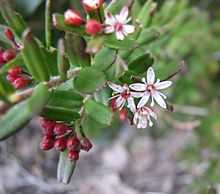Leionema bilobum
From Wikipedia, the free encyclopedia
| Leionema bilobum | |
|---|---|
 | |
| Leionema bilobum subsp. bilobum in Grampians National Park, Victoria | |
| Scientific classification | |
| Kingdom: | Plantae |
| (unranked): | Angiosperms |
| (unranked): | Eudicots |
| (unranked): | Rosids |
| Order: | Sapindales |
| Family: | Rutaceae |
| Genus: | Leionema |
| Species: | L. bilobum |
| Binomial name | |
| Leionema bilobum (Lindl.) Paul G.Wilson [1] | |
| Synonyms | |
| |
Leionema bilobum, commonly known as Notched Phebalium, is a shrub species of the family Rutaceae. It is endemic to south-eastern Australia. The species was first formally described by English botanist John Lindley from material collected during Thomas Mitchell's exploration of the Grampians. His description was published in 1838 in Three Expeditions into the interior of Eastern Australia. Lindley gave it the name Phebalium bilobum. The species was transferred to the genus Leionema by Paul G. Wilson in 2003. Four subspecies were formally described in 2006:[2]
- bilobum - the nominate subspecies from the eastern Grampian Ranges, Victoria.
- serrulatum - a long leaved form from Gippsland, Victoria.
- thackerayense - a form with smooth-edged leaves without a bilobed tip. Occurs in the Western Grampians Ranges (including Mount Thackeray) and the Black Range.
- truncatum - northern and eastern Tasmania.
-
Leionema bilobum subsp. serrulatum
References
- ↑ "Leionema bilobum". Australian Plant Name Index (APNI), IBIS database. Centre for Plant Biodiversity Research, Australian Government, Canberra. Retrieved 2010-10-19.
- ↑ Durham, K.L., James, E.A. & Ladiges, P.Y. (2006). "New subspecies of Leionema bilobum (Rutaceae)". Muelleria 23: 11–13.
This article is issued from Wikipedia. The text is available under the Creative Commons Attribution/Share Alike; additional terms may apply for the media files.
